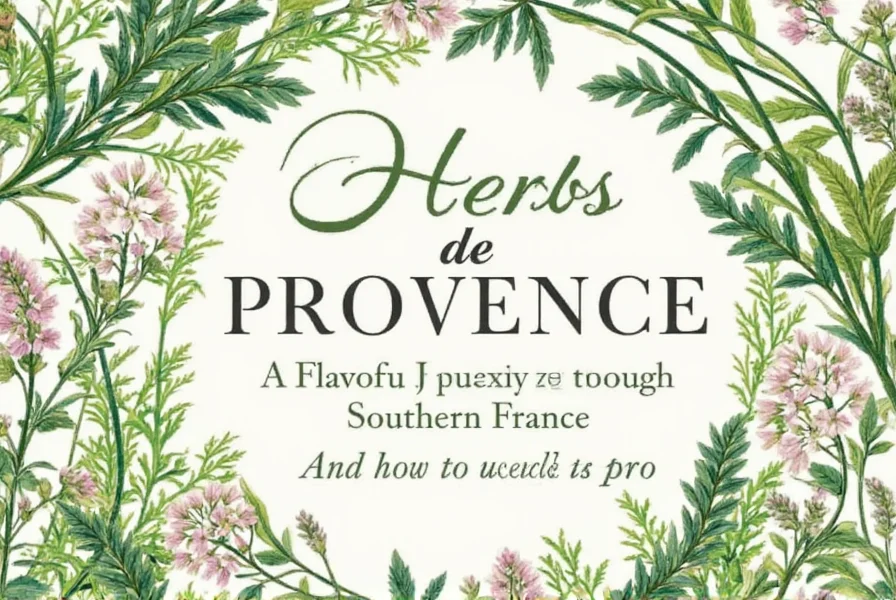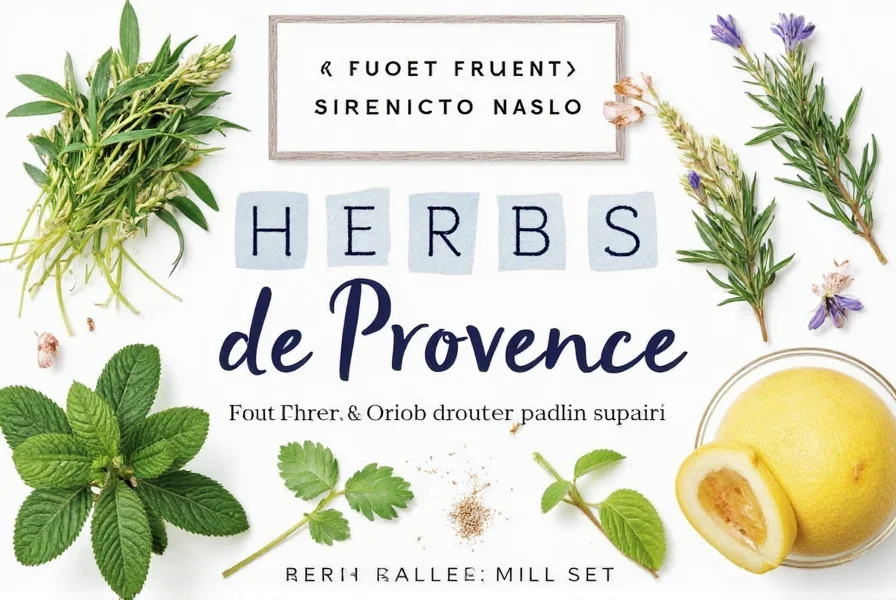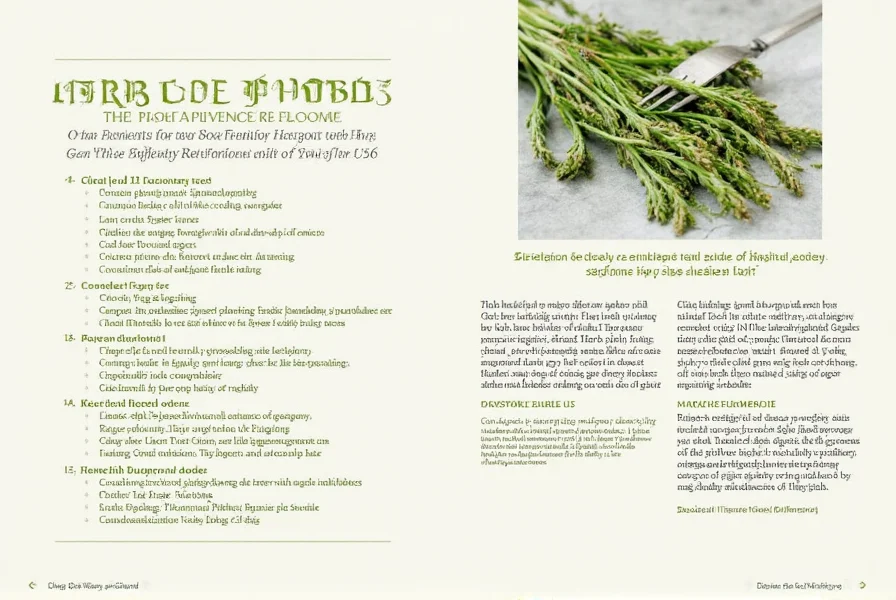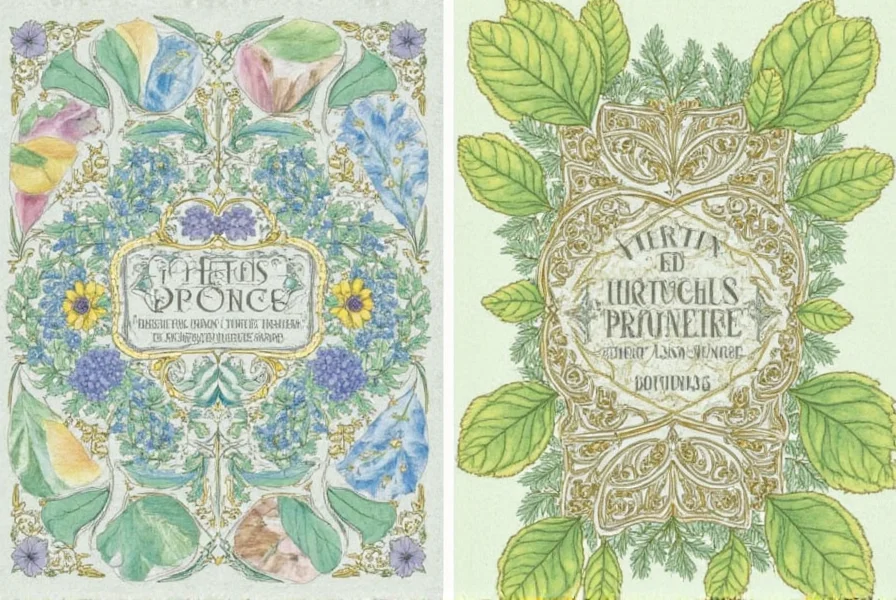Table of Contents
What Is Herbs de Provence?
Herbs de Provence is a traditional French herb blend originating from the Provence region of southern France. It typically includes thyme, rosemary, oregano, marjoram, and lavender, and is used to add a fragrant, Mediterranean flavor to dishes like roasted meats, vegetables, and soups. This iconic spice mix has been a staple in French cuisine for centuries, and its versatility makes it a must-have in any kitchen.

The blend was historically created by local farmers to preserve summer herbs for winter use. Modern versions maintain this tradition while adapting to global tastes. Authentic Herbs de Provence is regulated by French agricultural standards, ensuring quality and authenticity.
The Signature Herbs in Herbs de Provence
Understanding the key components of Herbs de Provence helps maximize its culinary potential. Here's a detailed breakdown of each herb:
- Thyme (40-50% of blend): Provides earthy, slightly minty notes. Essential for braising and roasting. High-quality thyme has bright green leaves with minimal stem content.
- Rosemary (20-25%): Offers pine-like aroma with citrus undertones. Ideal for lamb, potatoes, and bread. Look for finely chopped rosemary to prevent overpowering dishes.
- Oregano (15-20%): Delivers bold, peppery flavor. Complements tomatoes, beans, and grilled vegetables. Mediterranean oregano is preferred over Mexican varieties for authenticity.
- Marjoram (10-15%): Provides sweet, floral notes. Balances stronger herbs in sauces and dressings. Should have a delicate, fresh scent without mustiness.
- Lavender (5-10%): Adds distinctive floral complexity. Must be culinary-grade (not ornamental) to avoid bitterness. Authentic Provencal blends use Lavandula angustifolia.
Some premium blends include additional herbs like savory (1-2%) for extra depth or basil (1-2%) for summery notes. The ideal ratio ensures no single herb dominates, creating harmonious flavor.
Cooking Tips with Herbs de Provence
Maximize flavor by applying these professional techniques:
- Timing matters: Add dried Herbs de Provence early in cooking (15-20 minutes before finishing) for deep flavor infusion. For fresh herbs, add in the last 5 minutes to preserve delicate notes.
- Oil activation: Mix herbs with olive oil or melted butter before applying to proteins. This creates a flavor carrier that penetrates meat and vegetables more effectively.
- Temperature control: Avoid high heat (>350°F/175°C) when using lavender-heavy blends to prevent bitterness. For roasting, use 325°F (160°C) for optimal flavor development.
- Pairing guide:
- Chicken: 1 tbsp per pound with lemon zest
- Lamb: 2 tbsp per pound with garlic and red wine
- Vegetables: 1 tsp per cup for roasted root vegetables
- Bread: 1 tsp per cup of flour for focaccia or olive bread
- DIY blend: Create your own with 3 parts thyme, 2 parts rosemary, 1 part oregano, 1 part marjoram, and 0.5 parts culinary lavender. Store in dark glass jars away from light.

Try this signature recipe: Herbs de Provence Roasted Chicken. Rub 2 tbsp blend mixed with 2 tbsp olive oil over a 4lb chicken. Roast at 375°F (190°C) for 1 hour 15 minutes. Rest 10 minutes before serving. The skin becomes crispy while the meat stays moist and aromatic.
Buying Guide: Finding the Best Herbs de Provence
Key Quality Indicators
- Color: Vibrant green (thyme, rosemary) and purple (lavender) with no browning. Brown or dull colors indicate age or poor storage.
- Aroma: Fresh, herbaceous scent without mustiness. Crush a small amount between fingers to release fragrance.
- Label transparency: Must list all ingredients by percentage. Avoid blends with "natural flavors" or "spices" as vague descriptors.
- Harvest date: Look for "harvested within 6 months" or "best by" dates. Avoid products without date information.
Top Brands Compared
- Maison Lacroix: French origin, 100% organic, lavender at 8% ratio. Ideal for traditional French cooking.
- La Vache Qui Rit: Commercial brand with consistent quality. Contains 5% lavender, suitable for everyday use.
- Herbes de Provence by La Maison de la Cuisine: Premium blend with 10% lavender. Best for gourmet applications but may be too floral for some dishes.
- Spice House: American brand with 7% lavender. Excellent balance for beginners.
Storage Tips
- Keep in airtight glass containers away from light and heat
- Replace every 6 months for peak freshness
- Never store in the refrigerator (moisture causes clumping)

When purchasing, prioritize French-made products with AOC (Appellation d'Origine Contrôlée) certification for authenticity. Avoid supermarket bulk bins where herbs may be exposed to air and light.
Comparison Table: Fresh vs. Dried Herbs de Provence
| Feature | Fresh Herbs de Provence | Dried Herbs de Provence |
|---|---|---|
| Flavor Intensity | Stronger, more vibrant | Milder, more concentrated |
| Shelf Life | Shorter (best used within 3-5 days) | Longer (6-12 months when stored properly) |
| Usage | Best for garnishing or adding at the end of cooking | Best for adding during cooking or baking |
| Storage | Refrigerate in damp paper towel | Airtight container in cool, dark place |
| Cost | More expensive ($5-8 per ounce) | More affordable ($2-4 per ounce) |

For most home cooking, dried Herbs de Provence offers better value and consistency. Reserve fresh herbs for special dishes where vibrant color and aroma are critical.
Conclusion
Herbs de Provence represents the essence of French culinary tradition, transforming ordinary dishes into Mediterranean masterpieces. By understanding its components, proper usage, and quality indicators, you can consistently elevate your cooking. Whether you're roasting chicken, baking bread, or simmering sauce, this versatile blend delivers authentic flavor with minimal effort.
Remember: quality matters. Invest in certified French blends with transparent labeling for the best results. With proper storage and usage, Herbs de Provence will remain a kitchen staple for years to come.

Frequently Asked Questions (FAQs) about Herbs de Provence
What is Herbs de Provence exactly?
Herbs de Provence is a traditional dried herb blend originating from the Provence region of France. It typically combines thyme, rosemary, oregano, marjoram, and lavender to create a fragrant, versatile seasoning for Mediterranean-style cooking. Authentic blends adhere to French agricultural standards for ingredient ratios and quality.
Does every Herbs de Provence blend contain lavender?
Traditional Provencal blends include culinary lavender for its distinctive floral note, but some commercial versions omit it due to varying taste preferences. Authentic blends regulated by AOC standards typically contain 5-10% lavender, while modern variations may exclude it entirely. Always check the ingredient list for lavender content.
How much Herbs de Provence should I use per serving?
Start with 1/4 to 1/2 teaspoon per serving for subtle flavor. For rubs or marinades, use 1-2 tablespoons per pound of meat. Since potency varies by blend, always taste as you go—dried herbs intensify when cooked. For dishes with strong flavors (like lamb), use 1/2 teaspoon per serving; for delicate dishes (like fish), use 1/4 teaspoon.
Can I substitute Italian seasoning for Herbs de Provence?
While both are herb blends, they create different flavor profiles. Italian seasoning typically contains more basil and less lavender. For authentic Provencal flavor, substitute individual dried herbs: 1 tsp each of thyme, rosemary, and oregano plus a pinch of lavender. Avoid using Italian seasoning for traditional French dishes like ratatouille or bouillabaisse.
Why does my Herbs de Provence taste bitter?
Bitterness usually comes from excessive lavender (over 10% of the blend) or old, degraded herbs. Store blends in airtight containers away from light/heat, and use within 6 months. When making your own, use only 1 part lavender to 10 parts other herbs. If bitterness persists, try reducing the lavender content in your blend.
Is Herbs de Provence safe for daily consumption?
Yes, when used as a seasoning in normal culinary amounts. However, lavender in medicinal doses may affect hormones, so stick to culinary quantities (under 1 teaspoon per serving). Consult a doctor if consuming large amounts regularly. The French Ministry of Agriculture confirms culinary use of Herbs de Provence is safe for daily consumption.
What's the difference between Provencal herbs and Herbes de Provence?
"Provencal herbs" refers to fresh herbs grown in Provence, while "Herbes de Provence" specifically denotes the dried commercial blend. The dried blend has a more concentrated, earthy flavor compared to fresh regional herbs. Authentic Herbes de Provence must meet French agricultural standards for ingredient ratios, while fresh Provencal herbs vary by season and grower.










 浙公网安备
33010002000092号
浙公网安备
33010002000092号 浙B2-20120091-4
浙B2-20120091-4